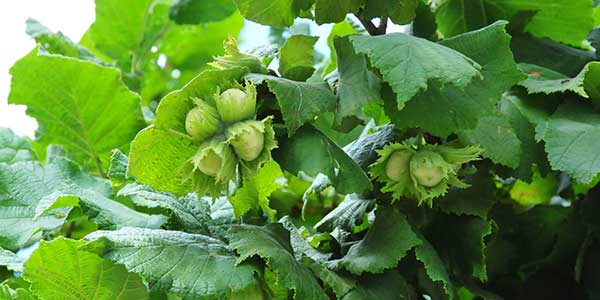There are only three nuts we can grow in our climate – walnuts, sweet chestnuts and hazelnuts – and the last is the only one which can be grown in a less than large garden. Hazelnuts are very nutritious, containing good fats (monounsaturated and polyunsaturated) folate, minerals, fibre and Vitamins B6 and E. Home-grown ones are really delicious, eaten fresh or toasted, for cooking and baking, or making a brilliant salad oil or your own Nutella. And they are very, very good for wildlife.
Cultivars developed from our native hazel, Corylus avellana, have round nuts with short husks, and are called cobnuts; cultivars from the non-native Corylus maxima have long nuts in a much longer husk, and are called filberts. However, the genes and names have become confused over the years – Kentish Cob is in fact a filbert.
Hazels carry male and female flowers, but they crop much better with a pollination partner. The male flowers are the catkins that delight us in January and February. The female flowers are tiny red tufts; they are wind-pollinated.

Good cultivars
Cosford Cob: Thin-shelled nuts with a good, sweet flavour, ripening late September. A vigorous, multi-stemmed bush and a very reliable cropper. A very good pollinator with bright yellow catkins, but does not pollinate Kentish Cob, apparently. Does well in most soils, but needs pruning twice a year to keep it a manageable height.
Nottingham (aka Pearson’s Prolific): A small, early-ripening filbert carrying large nuts with a rich flavour. Known to do well in Ireland, it’s a small cultivar, a reliable heavy cropper, comes into bearing early and is an excellent pollinator with pale yellow catkins.
Webb’s Prize Cob: Large nuts, with perhaps the finest, sweetest flavour. A small tree with a rather weeping habit, a reliable, heavy cropper, but a little slow at coming into bearing. One of the best for a smaller garden.
Kentish Cob AGM: The nuts are filberts, with an exceptional flavour. A compact, slow-growing cultivar with a bushy habit, and not a heavy cropper. Lovely yellow catkins.
Hall’s Giant: Heavy crops of medium-sized, late-season, shiny brown cobnuts with an excellent flavour. Small, vigorous tree or bush, extremely reliable, and an excellent pollinator. Best performer in the UK’s Agroforestry Research Trust tests in Devon. Pretty red-tinged catkins in late winter. A good choice in a difficult climate.
Red Filbert: Light crops of slender, shiny reddish-purple nuts with pink, frilly husks and a very good flavour, but the beauty of this hazel is its wonderful colour. A small tree or large bush with wine-purple spring foliage, turning green in summer, and wine-coloured catkins in late winter. The colour is best if planted in full sun.

How to grow hazels
Hazels like a light, well-drained, moisture-retentive, reasonably fertile, neutral to alkaline soil, although it should not be too rich, or you will get masses of vegetative growth at the expense of nuts. They do best in a sunny, warm, sheltered site, and will tolerate light, dappled shade. Cobnuts are a little less hardy than filberts, but the temperature has to go below -10ºC for cobnut cropping to be affected, so we are rarely troubled here in Ireland.
Our hazels usually come as a multi stemmed bush, most of our customers grow them like this. For those who want to give them more attention, they are best grown on a short trunk, which makes pruning, sucker-removal and harvesting much easier. To start this form of pruning, you will need to select one strong branch as a leader and prune the rest. If you’re planting a nut orchard, plant them in a square, to help with wind-pollination. If you have just a couple of hazels, shaking the branches during winter pruning will pollinate them just fine. They don’t need many nutrients, although a potassium-rich fertiliser helps on poor soils, and a good mulch is useful for keeping the soil moist. Water in dry spells. Prune in late winter to keep the trees manageable, and remove suckers from the roots, or you will produce a thicket. If the tree is not cropping well, breaking the twigs in summer and leaving them dangling (‘brutting’) will help.
The main pests are squirrels; a good hunting cat may help, but if you have squirrels, there’s no denying that they will get there before you. There’s no point in harvesting early, as under-ripe nuts tend to shrivel in store.
The nuts ripen in September, and are ready when the husks turn yellow and nuts begin to fall. They can be dried in a single layer on trays in a warm place for three weeks, and stored in mouse-proof containers until the New Year, after which they may become rancid. Cracking and eating hazelnuts over the Christmas is a lovely way of using them up.

Hazels are also wonderful under-storey trees in a woodland planting of oak and ash (if ash-dieback is not already in your area). If they’re coppiced (cut almost to the ground) every seven years or so, they live for centuries, and will provide you with long, tough shoots for beanpoles and obelisks, brash for peasticks, and pliable twigs for thatchers, should you know any. Coppicing opens the canopy, so bluebells and other woodland flowers and fungi will flourish in the unaccustomed light. You won't get many nuts, but squirrels, wood mice, jays and woodpeckers will visit, and, in the east of the country, a recent arrival, the delightful common or hazel dormouse. Early-emerging bees like the pollen and the caterpillars of several moths eat the leaves. A brilliant all-rounder for wildlife.




